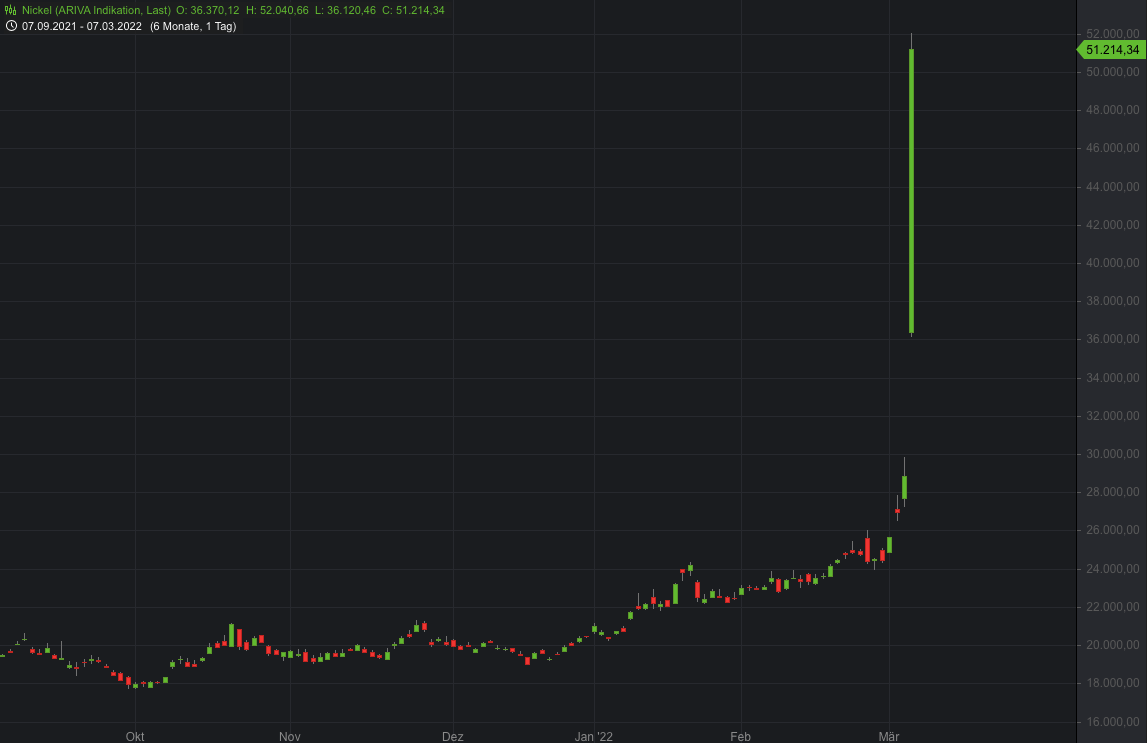Nach einem gigantischen Short-Squeeze ist der Preis für das Industriemetall Nickel kürzlich auf über 100.000 US-Dollar pro Tonne gesprungen. Die altehrwürdige London Metal Exchange (LME), an der Metalle gehandelt werden, hat daraufhin den Handel mit Nickel am 7. März 2022 ausgesetzt – was bei vielen Tradern für Verärgerung gesorgt hat.
Für mich war das Thema auch insofern relevant, als ich einen Rohstoffkorb beobachte, der neben Kupfer, Aluminium und Zink eben auch Nickel trackt. Zwar sind im Zertifikat „Industrial Metals“ (ISIN: DE000A0KRKG7) von Wisdom Tree laut Produktinformationsblatt nur etwas mehr als 15 Prozent Nickel. Bei derart exorbitanten Preissprüngen muss man sich aber natürlich fragen, wie es diversen Marktteilnehmern noch möglich ist, halbwegs reele Preise für derartige Rohstoffkorb-Produkte zu stellen.
(Grundsätzlich sollte man wissen, dass das Produkt den Bloomberg Industrial Metals Subindex (BCOMIN) repliziert, also nachbildet.)

Nachdem ich kurz nach Trading-Halt für Nickel an der LME verschiedene deutsche Börsen und deren Ask und Bid für das genannte Zertifikat genauer beobachtet hatte, wurde mir schnell klar, dass es hier große Preisunterschiede gibt – und auch die Spreads waren nicht nur sehr unterschiedlich, sondern teilweise absurd hoch.
Ich habe also bei Wisdom Tree nachgefragt, welchen Einfluss es auch ein Zertifikat hat, wenn (konkret: mit Nickel) ein Bestandteil des zugrundem liegenden Rohstoffkorbs an einer bedeutenden Börse wie der LME vom Handel ausgesetzt wird.
Die Antwort des Unternehmens:
At the point when Nickel futures are put on halt by the LME the price of the Nickel futures underlying the index no longer updates, so its ability to influence the performance of the BCOMIN index is limited to the last available price.
Wisdom Tree Europe
Und das Problem liefert der Support noch gleich mit:
WisdomTree Industrial Metals’ quotes of market participants cannot behave like the index, they are pricing a basket with nickel in it, but the main reference point for pricing is missing.
Wisdom Tree Europe
Und was bedeutet es nun für den Preis eines solchen Rohstoffzertifikats/ETCs, wenn eben ein wichtiger „Referenzpunkt“ zur Preisbindung hier fehlt?
During this period, investors can expect that ETPs that replicate Nickel will be subject to wider spreads and potential trading disruptions that reflect uncertainties in the underlying market. This may result in temporary or prolonged removal of bid/offer prices for ETPs replicating nickel, very wide bid/offer spreads or auctioned products. It can also result in deviations between the performance of a continuously traded product and an index that cannot, by construction, attempt to estimate the value of nickel, but must „settle“ for showing the most recent price.
Wisdom Tree Europe
Wahrscheinlich ist es aktuell also am besten zu warten, bis sich die Rohstoffmärkte wieder etwas normalisiert haben. Es scheint aktuell tatsächlich so, als ob es für Nickel keinen allgemeingültigen „Marktpreis“ gibt.
Die LME hat sich übrigens mittlerweile entschlossen, die täglichen Preisänderungen für Nickel auf +/- 15 Prozent zu begrenzen. Eine Regelung, die viel Kritik auf sich gezogen hat, wohl aber verhindern soll, dass ähnliche Preissprünge wie Anfang März zum Standard werden…
Weitere thematisch relevante Meldungen:
Trafigura Bought Some LME ‘Nickel’ That Was Just Bags of Stones
Bloomberg, 21.03.2023
Market Will Be Broken Even After the LME Is Fixed,
Bloomberg.com, 21.03.2022
Nickel’s Rapid Cool-Down Pushes London Price Near to China’s,
Bloomberg.com, 22.03.2022
Nickel Market Still Broken as Price Swings Wildly on Low Volume,
Bloomberg.com, 25.03.2022
Big short keeps nickel market on edge one month after squeeze,
Bloomberg.com, 08.04.2022
LME Faces Rare UK Probe Into Conduct During Nickel Crisis
Bloomberg.com, 03.03.2023
What Really Happened the Night the Nickel Market Broke
Bloomberg, 21.06.2023

